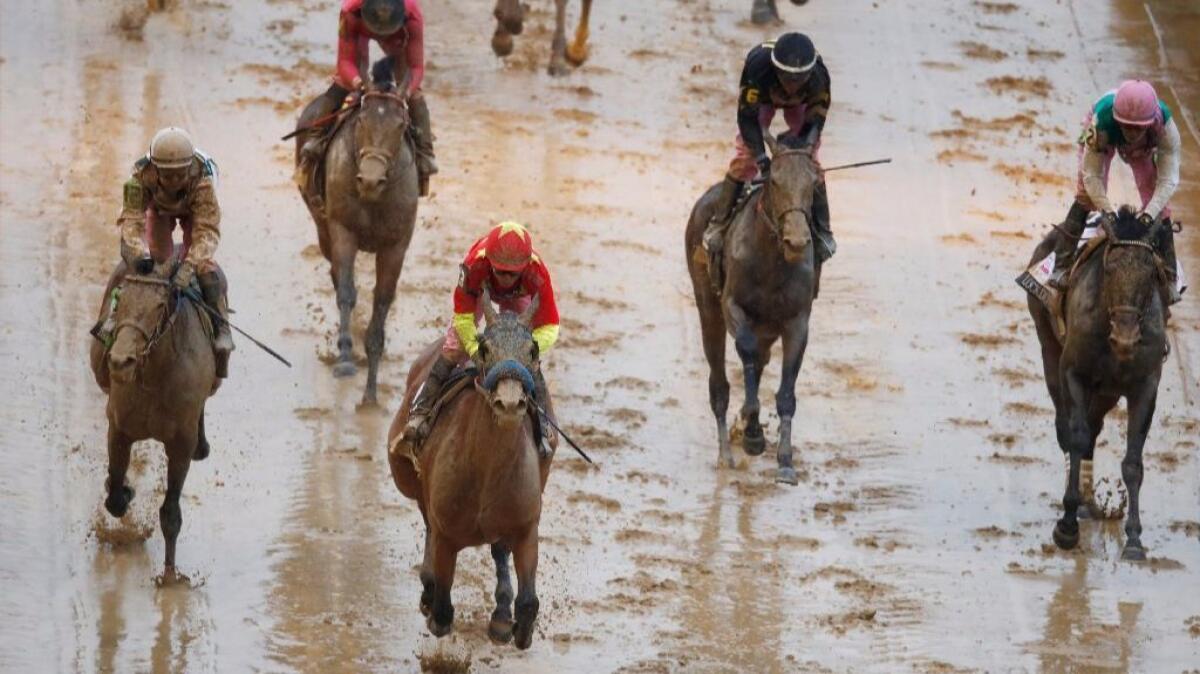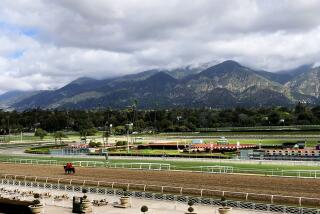You always remember your first time, although jockeys don’t find it a big deal

- Share via
Reporting from Baltimore — You would never think of buying a car without test driving it. Or when you go to the rental car counter, you’re often given a choice, so you pick the vehicle with which you’re most familiar.
So how is it that jockeys can get on a horse without ever having ridden or worked the animal and make it look like they are lifelong friends?
If you ask the best — and in this case, that’s Mike Smith — they will tell you it’s no big deal to have your butt on a horse for the very first time seconds after the “riders up” call.
Smith will be doing just that for the second straight Triple Crown race Saturday when he rides Gunnevera in the Preakness.
This will follow his ride on Girvin, a horse he had never ridden, in the Kentucky Derby two weeks ago.
“It’s not that complicated,” Smith said. “You talk to the owners and trainers. You’ve got all the previous races that you can watch on video. At this point, these horses are so well trained, it’s just a matter of getting them to run their race.”
Three other jockeys will be riding a horse for the first time in the Preakness. Javier Castellano got off Gunnevera to ride Cloud Computing, Joel Rosario will be riding Multiplier for the first time and Term of Art, running his first race outside California, will have Jose Ortiz aboard.
Joe Talamo, who is one win behind in the Santa Anita jockey standings, won Sunday’s Angel Flight Stakes riding Faypien for the first time.
He echoed Smith’s idea that it’s not the mystery it used to be.
“Reading the Racing Form gives you a good idea,” Talamo said. “But it’s even more important to watch the replays. The last five, 10 years, you can easily watch every race a horse has run.”

Smith already has done most of his studying on Gunnevera, a horse that likes to save his best running for late.
“I’ve seen all his previous races,” Smith said. “I’ve been interested in him for a little while. His last two trips [Florida Derby, third; Kentucky Derby, seventh], he hasn’t gotten a chance to run his race. In the Fountain of Youth [a win], he ran his race.”
Smith also plans to talk to Castellano about the horse.
“[Other jockeys] are always helpful,” Smith said. “You do it for everyone.”
Regardless of the quality of your jockey, having Smith on board is never a negative.
“Mike Smith is a nice person and a great rider,” Gunnevera trainer Antonio Sano said. “He likes this horse, and he wants to ride him. Mike Smith wins the most important races in the world.”
Smith now seems to find himself atop most of trainer Bob Baffert’s best horses, including Arrogate, winner of the Dubai World Cup and Breeders’ Cup Classic, and Kentucky Oaks winner Abel Tasman.
The Hall of Fame trainer and Hall of Fame jockey usually don’t have to talk strategy.
“If there is something very specific, he’ll tell you,” Smith said. “But for the most part, you know who’s in the race. You know what [your horse] is capable of or what type of race to run to get their best race.
“He [Baffert] knows I’ve done my homework. He leaves it to me to go to Plan C, if A or B isn’t working.”
When Talamo rode Baffert’s Faypien to a win on Sunday, the only thing assistant trainer Jimmy Barnes told him in the paddock was “good luck.”
“We had the same idea on paper,” Talamo said. “It looked like there were a couple of speed horses. … We had a good post position [the six in a six-horse field]. Drawing the outside has so many benefits. We were kind of in a good spot.”
Smith was in a bad spot when he won the Kentucky Oaks on Abel Tasman, having to rally from last. It was the second time he rode the horse.
The filly ended up at the back over a poor surface. Both Smith and Baffert thought the place to be would be the inside based on previous races that day. The problem was Abel Tasman didn’t like it there, so Smith moved her outside. From there, she started running and didn’t stop until the finish line.
Here was a case where Smith picked up something from the first time he rode the filly, a well-beaten second to Paradise Woods in the Santa Anita Oaks. It made the second ride that much better.
Baffert says Smith said unsolicited that the filly needed blinkers, something that had been suggested earlier by Martin Garcia, one of Baffert’s regular riders who often works the horses.
Smith says it was Baffert who brought up the idea, which he seconded.
“She was not 100% focused,” Smith said after the Kentucky Oaks. “She would get ahold of you for about a 16th of a mile, and there was a little bit of focus again. It’s a good indication they probably need just a little bit of a blinker.
“So as soon as we get off, [Baffert says], ‘What do you think about a little bit of a blinker?’ and I said, ‘I was just getting ready to tell you that.’ ”
The fact that Smith was available on these horses was just a matter of bad luck.
He was the regular rider on Mastery, who was looking to be the Kentucky Derby favorite, until he suffered a likely career-ending injury moments after the San Felipe Stakes at Santa Anita.
So he picked up mounts on Girvin and now Gunnevera.
Smith also was the regular rider for Unique Bella, who was looking to be the top filly in the country until she came down with a shin injury.
So he picked up the mount on Abel Tasman.
Smith has won only one Preakness, aboard Prairie Bayou in 1993, but says he’s looking forward to riding at Pimlico.
“I enjoy riding anywhere I have a good horse,” Smith said. “But I’m due for a win.”
Follow John Cherwa on Twitter @jcherwa
More to Read
Go beyond the scoreboard
Get the latest on L.A.'s teams in the daily Sports Report newsletter.
You may occasionally receive promotional content from the Los Angeles Times.











